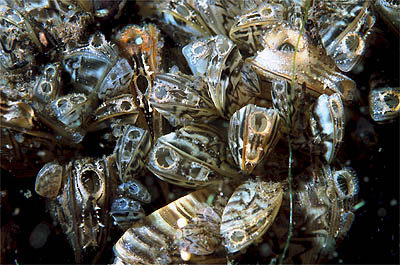
From the official press release . . .
Glacier National Park continues its boat inspections and permit process for this summer as part of an ongoing aquatic invasive species (AIS) prevention program. Westward expansion of zebra and quagga mussels, and other aquatic invasive species transported mainly on recreational watercraft, is driving regional water resource managers to ramp up existing AIS prevention strategies. Mussel infestations are increasing across the country, and present greater threats to park waters as more boats testing positive for mussels are intercepted in the northwest each year.
Invasive mussels are found on boats within Montana or passing through Montana on a regular basis. Eurasian watermilfoil and other invasive aquatic plants are also present in western Montana waterways, necessitating a high degree of vigilance to prevent spread.
A National Park Service inspection is required for all motorized and trailered watercraft. A self-certification permit is required for all non-trailered, hand-propelled watercraft. Park managers encourage all boaters to thoroughly clean, drain, and dry their watercraft and/or fishing equipment before coming to the park to prevent the spread of aquatic invasive species.
“We realize that recreational boaters will face added time and inconvenience while recreating in Glacier National Park,” said Brian McKeon, supervisor for the AIS Inspection Program. “The consequences of Aquatic Invasive Species becoming established in park waters at the headwaters for the Columbia, Missouri and Hudson Bay watersheds are dire for aquatic ecosystems, recreational opportunities, and economic concerns downstream.”
A NPS inspection is required for all motorized and trailered watercraft:
- A thorough boat and trailer inspection is required upon every entry to the park. Trailered hand propelled watercraft, including rafts and rowboats, still require a trailer inspection by park staff. A successful inspection will result in a free permit to launch. A boat may launch multiple times provided the boat does not leave the park between launches. A new permit is required upon each re-entry into the park.
- Inspections may take upwards of 30 minutes, depending on the complexity of the boat. Boaters should plan on additional time for inspections.
- To receive a permit, boats must be clean, drained and thoroughly dry (including bilge areas and livewells) upon inspection. A boat that is clean, drained, and dry is much easier to inspect and will speed the inspection process greatly.
- Inspectors may hose down the outer hull and motor areas of boats to remove road grime. This is only to facilitate inspection. It is not a decontamination procedure. Heavily soiled boats, boats that arrive with any standing water in the boat (including livewell and bilge areas), and boats with inaccessible internal ballast tanks will not be issued a permit.
- Though launch hours are not restricted, inspection hours are limited. Hours vary throughout the park and will be adjusted seasonally. Beginning Memorial Day, permits are available from 7:00 a.m. to 9:00 p.m. at Park Headquarters (Station closure time will be adjusted as summer daylight wanes) and 8:00 a.m. to 4:30 p.m. at all other locations – St. Mary Visitor Center, Two Medicine Ranger Station, and the Many Glacier Ranger Station.
- Boaters wishing to launch on Bowman Lake must obtain a permit at Park Headquarters, and then immediately proceed to Bowman Lake after the inspection.
- Permits are available the rest of the year between 8:00 a.m. and 4:30 p.m. Boaters should be prepared to wait longer for inspections in the off-season (fall/winter/early spring) due to limited inspection personnel. Please call ahead if you can estimate your arrival time, (406) 888-7800.Boaters on Waterton Lake must comply with permit and inspection requirements of Parks Canada.
- Boats with internal ballast tanks or other enclosed compartments that exchange water with the environment and that cannot be readily cleaned, dried, and fully inspected or removed are prohibited from launching in Glacier National Park.
- Boats failing inspection will be denied a permit. Boaters may re-apply for a permit after their boat is thoroughly cleaned, drained and dried.
- Boats found with infestations of AIS species may be quarantined until they are fully decontaminated.
A self-certification permit is required for all non-trailered, hand-propelled watercraft:
- Non-trailered, hand-propelled watercraft (canoes, kayaks, rowboats, rafts, catarafts) being launched within the park are required to obtain an AIS self-certification permit. The self-certification permit is free, completed by the boater, and must remain with boaters while they are floating. It is available at all park visitor centers, backcountry permit offices, park headquarters, and at maintained boat launches. Boaters can also download the permit before they come to the park from Glacier’s website at http://www.nps.gov/glac/planyourvisit/boating.htm. The self-certification permit is reusable within the current calendar year. Boaters may recertify by performing another inspection and signing the back of the same permit.
For rules and regulations on boating, please visit the park’s web page, http://www.nps.gov/glac/planyourvisit/boating.htm
For more information on AIS, please visit the AIS web page, http://www.nps.gov/glac/planyourvisit/ais.htm